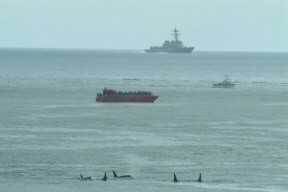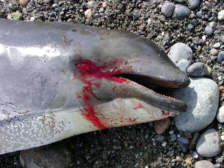|
On 5 May 2003, the US Navy Guided Missile Destroyer "Shoup" DDG 86 conducted sonar operations for five hours in the Strait of Juan de Fuca and in Haro Strait between Vancouver Island, creating one of the most obvious displays of marine mammal harassment that experienced observers have ever seen, anywhere. The terrorized whales and porpoises in the region could not escape the intense mid-frequency (3 kHz) long duration "pings" from the ship's SQS 53C sonar; and, several porpoises are reported to have "coincidentally" stranded and died following the sonar event. The carcasses of these mammals have been collected for forensic examination for acoustic pressure trauma (bleeding in ears and brain).
By chance, J pod of 22 killer whales was in Haro Strait at the time of the sonar operations. Observers noted that they abruptly stopped their feeding and gathered in a tight group to swim close to shore at the surface for the duration of the sonar exercise. The sonar "pings" were so powerful (>200 dB re 1 uPa) that they could be heard in air by visitors along the shoreline of San Juan Island.
The US Navy is seeking exemption from the Endangered Species Act and the Marine Mammal Protection Act in Congress this week, in part because they know they are the most egregious of marine mammal harassers and killers worldwide. Since March 2000, when they chased 17 whales ashore in the Bahamas, the Navy has known that their sonar kills and injures whales at distances well beyond the visual horizon, yet they continue to "exercise" in inappropriate and confined waters killing these innocent animals.
In just this one day that we recently videotaped, the Navy's lethal sonar adversely impacted every marine mammal within twenty miles of the ship. No wonder marine mammals are stranding and their populations are declining. This is a literal "no-brainer" for the Navy and the whales.
Ken Balcomb
Center for Whale Research
Eye-witness Report by David Bain:
The passage of naval vessel 86 was observed by me and students in the marine mammal class at Friday Harbor Labs. Collectively, we observed effects on three species.
Dall's porpoises were observed in a bay north of Lime Kiln Lighthouse as the ship approached. After the ship passed, they were observed traveling away from the ship at high speed. This is similar to the behavior of Dall's porpoises in the presence of other loud sounds, such as air gun blasts.
A minke whale was observed porpoising as it passed Lime Kiln Lighthouse going north ahead of the vessel. I heard a whale watch operator report a porpoising minke whale north of Lime Kiln Lighthouse. I observed a porpoising minke whale just south of the Center for Whale Research. I heard another whale watch operator report a porpoising minke whale north of the Center for Whale Research. It has been about 20 years since I've seen a minke porpoising. A minke whale was observed fairly regularly in the vicinity of False Bay, so I believe the reports of the porpoising minke are probably of a single individual, that this individual initiated its escape behavior in the vicinity of False Bay, and that it traveled for 5-10 miles at a high rate of speed. Subsequent to the passage of the naval vessel, we observed a minke whale in Boundary Pass, although we had not seen one up there previously. If this is the same minke that was in the False Bay area, it would represent a significant range shift.
Killer whales were observed behaving normally until the sonar became audible in air. We could see the superstructure of a naval vessel over the horizon in Juan de Fuca Strait, although we could not see the hull. The J's moved inshore and grouped tightly. As we moved inshore with them, the naval vessel disappeared over the horizon, although the sonar was still audible. The J's then moved quietly northward. We did not see J39 being playful as usual, and overall the group behavior seemed "inconspicuous."
Once the J's rounded Edwards Point, they picked up speed and split up a little bit, although they remained near shore. After they passed Lime Kiln Lighthouse, they bunched up again, and remained tight until reaching the Center for Whale Research, where they stopped. They then made a quick move to the south as the vessel moved north past them. They stopped before leaving Andrews Bay, and turned north toward the vessel, but didn't move back toward it very far. They then turned south. Part of the pod continued south, but the remainder stayed in Andrews Bay. After the sonar was turned off, the northern portion of the pod continued north, and began to move offshore. We did not see the southern portion of the pod rejoin them, although I understand they were later seen traveling north at a high rate of speed to catch up with the rest of the pod.
There have been a number of porpoise strandings recently. Some of these pre-date the passage of vessel 86 through Haro Strait. Mid-frequency sonars were heard in April as well, although these seemed to be coming from Juan de Fuca Strait or points south. Thus these earlier strandings were potentially related to other sonar activity. Necropsies may reveal whether there was any involvement of sonar in their deaths.
As for what people can do, it seems the most important thing is to block legislation designed to exempt the Navy from environmental laws. Many of these laws were first passed during the Vietnam War, when preparedness for attacks by the Soviet Union was high as well. We still have troops deployed in Afghanistan and Iraq fighting the war on terror, but the recent successes of the US military have shown they are a formidable force, even with environmental constraints. The threats arrayed against the United States at this time are minor compared to what we faced when the environmental laws proposed to be overturned were first passed. The passage of vessel 86 through Haro Strait illustrates that the Navy is not yet ready to make decisions reflecting the will of the people without consultations with civilian agencies, and that it is important that civilians retain the right to use the courts to seek enforcement of environmental protection rules.
In addition, the Department of Defense is reviewing research proposals designed to prevent incidents like last week's from happening. It is important that as many of these proposals as possible are funded, and that the Navy proceed with caution until such programs are completed and the Navy can accurately predict where it can operate dangerous equipment without causing undue environmental damage.
While the passage of vessel 86 in the presence of many commercial and recreational whale watching vessels, scientists, and students provides a well documented example, many naval operations take place out of sight. It is important that the Navy review all operations that may be affecting or may have affected Southern Residents, such as weapons testing in British Columbia, Washington, Oregon, and California, in addition to sonar practices. To date, recovery planning efforts for this population have focused on prey availability, toxins, and whale watching in inshore waters. However, it is the whales that spend the most time in offshore waters that have suffered the greatest decline, and another factor such as naval operations may need to be identified to account for this.
While local concern focuses on orcas, there is potential for activities to affect other species, such as beaked and fin whales, in addition to porpoises and minke whales, and these possibilities should be examined at the same time. I'd suggest a thorough review of stranding records and military operations on the west coast (and around the world for that matter).
Finally, it is important that civilian concerns are relayed to decision makers within the military. These might be most effectively channeled through senators and congressmen. Successfully persuading Congressman Norm Dicks, who is very influential in military matters in Washington State and in whose district porpoise strandings have recently occurred, to weigh in on the side of conservation, is probably the most important channel for this. If the exemption from environmental laws goes through, this will be the last hope for environmental protection. Senators Cantwell and Murray may be in the best position to maintain legal protection for the environment, and are likely to be sympathetic ears. Other local congressmen, such as Rick Larsen, in whose district this recent incident took place, and Jay Inslee, who has expressed concern about this issue, would be good contact points.
I hope these thoughts are helpful.
Dave
Below is a list of phone numbers, faxes & emails for those of you who wish to contact your Washington Senators & Reps in DC regarding the Sonar Incident and/or the proposed exemption of the Military from Environmental regulations, the MMPA, and the ESA:
WHO TO CALL, FAX or EMAIL:
Senator Patty Murray (D- WA)
DC Phone: 202-224-2621
Fax: 202-224-0238
Email: senator_murray@murray.senate.gov
Senator Maria Cantwell (D- WA)
DC Phone: 202-224-3441
Fax: 202-228-0514
Email: http://cantwell.senate.gov/contact/index.html
Representative Norman D. Dicks (D - 06)
DC Phone: 202-225-5916
Fax: 202-226-1176
Email: http://www.house.gov/writerep/
Representative Richard R. Larsen (D - 02)
DC Phone: 202-225-2605
Fax: 202-225-4420
Email: rick.larsen@mail.house.gov
Representative Jay Inslee (D - 01)
DC Phone: 202-225-6311
Fax: 202-226-1606
Email: http://www.house.gov/inslee/email_new_form.htm
Representative Jim McDermott (D - 07)
DC Phone: 202-225-3106
Fax: 202-225-6197
Email: http://www.house.gov/writerep/
Representative Brian Baird (D - 03)
DC Phone: 202-225-3536
Fax: 202-225-3478
Email: http://www.house.gov/baird/zipauth.htm
Representative Richard (Doc) Hastings (R - 04)
DC Phone: 202-225-5816
Fax: 202-225-3251
Email: http://www.house.gov/writerep/
Representative George R. Nethercutt, Jr. (R - 05)
DC Phone: 202-225-2006
Fax: 202-225-3392
Email: http://www.house.gov/nethercutt/contact/get_address.html
Representative Jennifer Dunn (R - 08)
DC Phone: 202-225-7761
Fax: 202-225-8673
Email: http://www.house.gov/writerep/
Representative Adam Smith (D - 09)
DC Phone: 202-225-8901
Fax: 202-225-5893
Email: http://www.house.gov/adamsmith/contact/ContactForm.html
Source
ORCA NETWORK
|

